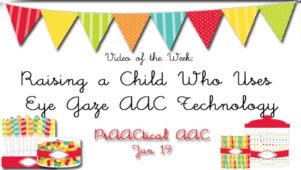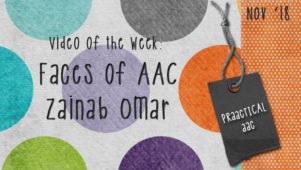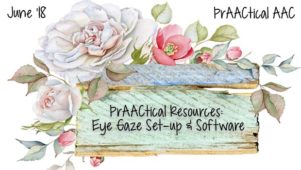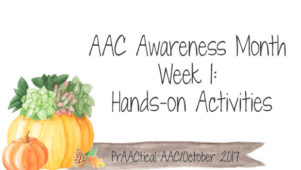The Faces of AAC: Gretchen and Zach
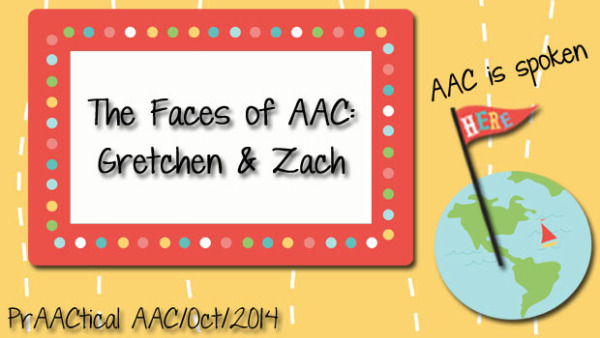
From Bielsko, Poland, to Denver, USA, we are continuing to share the Faces of AAC. Today, we meet SLP Gretchen Storm, who works in the public school system and has a private practice. Gretchen enjoys collaborating with parents, children, teachers, other healthcare providers, siblings and peers in strategies and facilitating communication through speech generating devices. In this post, Gretchen introduces us to Zach.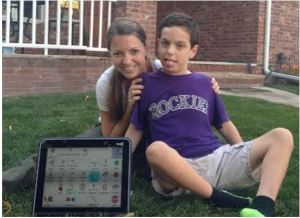
::::::::::::::::::::::::::::::::::::::::::::::::::::::::::
Zach is an 11 year old who uses a Tobii I-12 eye gaze communication device to communicate. He previously used a switch scanning method on a VMax from Dynavox. Zach recently switched to an eye gaze device. Though he loves to use his arms and hands whenever possible, his motor control of them is not ideal for the consistent switch access needed for switch scanning. He was switched to an eye gaze system which could also serve as a switch scanning device if in the future he demonstrates improved motor control of his hands. Eye gaze has been much more successful for Zach.
The Communication Device: The Tobii I-12 keeps track of where on the computer screen a user is looking by sending out near-infrared light and measuring how it reflects on the eyes. The user just has to look at the various icons on the screen to highlight them. To select, the user can either hold their gaze on a specific location, blink or use a switch. When Zach holds his eye gaze on an icon, the icon is selected and spoken out loud. Zach was evaluated in-depth for correct positioning in his chair prior to setting up his communication device for optimal access.
We spend a lot of time working on functional communication using core vocabulary as a base. We work on reading and writing using a variety of strategies suggested by UNC’s Center for Literacy and Disabilities paired with Dr. Gloria Soto’s research and strategies from San Francisco State University. Page Set Central, a website with pre-made pages for the Tobii has also been a valuable tool. We have worked hard to make sure his eye gaze device is equipped for success in a variety of communication situations. Zach’s vocabulary includes a combination of pre-stored phrases for daily occurring social situations and single core words which can be combined into novel sentences for all other times of his day. Some examples of pages with pre-stored phrases include greeting his peers, asking his peers questions, helping with attendance, pages for telling jokes and reading stories aloud to himself. On other pages he has a vocabulary where each icon only says one core word. He can then independently combine these words into his own phrases and sentences. These core vocabulary words are key to ensuring Zach has vocabulary which will work in any situation.
Zach’s Story: Zach is a 6th grader this year. If you asked him about himself a year ago, you would have found yourself in a guessing game of yes/no questions. Likely you would not have asked him questions such as, “What was the last half marathon you completed?” or “When do you plan to complete your next triathlon?” You may have asked about summer camp, but never would have thought to ask him about the SpongeBob costume he wore there. Okay, we’ll give you the benefit of the doubt, assume you are actually a very good guesser, and do happen to ask Zach these things. Two years ago his most reliable communication form was head nods for yes and no. Your conversation would have gone like this. “I heard you did a half marathon.” Head nod “yes”. “Which one did you do?” No comment from Zack; he can’t answer that with a nod. “Did you do the Rock and Roll half?” Head nod no. Did you do the Park to Park Half?” Head nod no. “Did you do the Urban Half” Head nod no. Now he’s bored and you aren’t guessing right. He’ll lose interest and begin focusing on the SpongeBob shirt the speaker is wearing. Zach would love it if you told him about that! This was a common conversation for him; Very one-sided and often relied heavily on information that his family and friends provided to the conversation partner. Many of the conversations people would have with Zach often faded out due to poor guessing or running out of topics. He never really got to talk about the stuff that interested him. It was frustrating!
If you asked Zach today to tell you a little bit about himself, he would give you an earful. You would learn that he just started middle school. This past Spring Zach completed a half marathon with two close friends. Over the summer he was really busy and went to camp where he dressed up as SpongeBob. Zach would explain that his friends, Chelsea and Nate, came to visit. Following that statement, he might ask you about the summer camp you attended.
How on earth does someone go from head nods to participation in back and forth communication in just two years’ time? Well the truth is, his thoughts and interests have 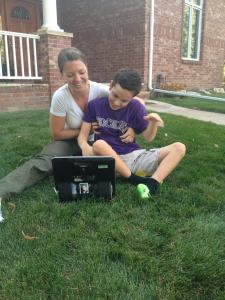 always been there. Zach has always had things that he wanted to say. He has always understood what people were saying. He just couldn’t effectively respond and people couldn’t read his mind. So there we were, limited and a bit stuck.
always been there. Zach has always had things that he wanted to say. He has always understood what people were saying. He just couldn’t effectively respond and people couldn’t read his mind. So there we were, limited and a bit stuck.
Luckily Zach had a family who advocated for him. His speech-language pathologist and teacher realized there were more efficient forms of communication. Luckily, they set him up on an Eye Gaze Communication device that changed his life, because now he has a voice to tell everyone how awesome they are. Zach has a voice to tell you when he’s bored and to tell you when he’s excited. His life has become even more humorous, now that he can tell you to take him out of his chair only to promptly tell you to put him back in. Zach has started telling jokes and participating in conversations with others. He can communicate with anyone, not just the good guessers and the close friends. Eye gaze technology has been a lot of hard work to learn, but each day he is more engaged in the world around him.
Where we are now: Zach now works with a speech-language pathologist once a week after school to target using his eye gaze communication device. He continues to work very hard to learn to navigate pages and create his own phrases. It has not been easy! It has taken hours and hours of patience, repetition and hard work on everyone’s part. This is the first Tobii eye gaze system I, the speech-language pathologist, have worked with. It has been a huge learning curve for everyone. There have been a lot of trial and error situations with vocabulary set-up, icon sizes and with learning the programming. Frequent communication with Zach’s school has been essential to determine priorities for language in the school setting. The communication device vocabulary is still nowhere near perfect, but it is so much better and more functional than it was even a just few weeks ago. We take everything in small steps and are seeing big results as a reward. Zach is developing an independent voice for the first time in his life!
Though we have made significant gains and progress it is important to know we still have a long way to go. These changes don’t happen overnight. Communication devices are a long and ongoing process. As Zach’s becomes older his vocabulary needs will change, he will continuously have different life events he wants to share with others and will be exposed to new more complex language situations. Eventually we hope to make Zach more independent with programming his own communication device to increase his independence with it.
Filed under: PrAACtical Thinking
Tagged With: AAC Awareness, eye gaze, Faces of AAC, Gretchen Storm
This post was written by Carole Zangari

